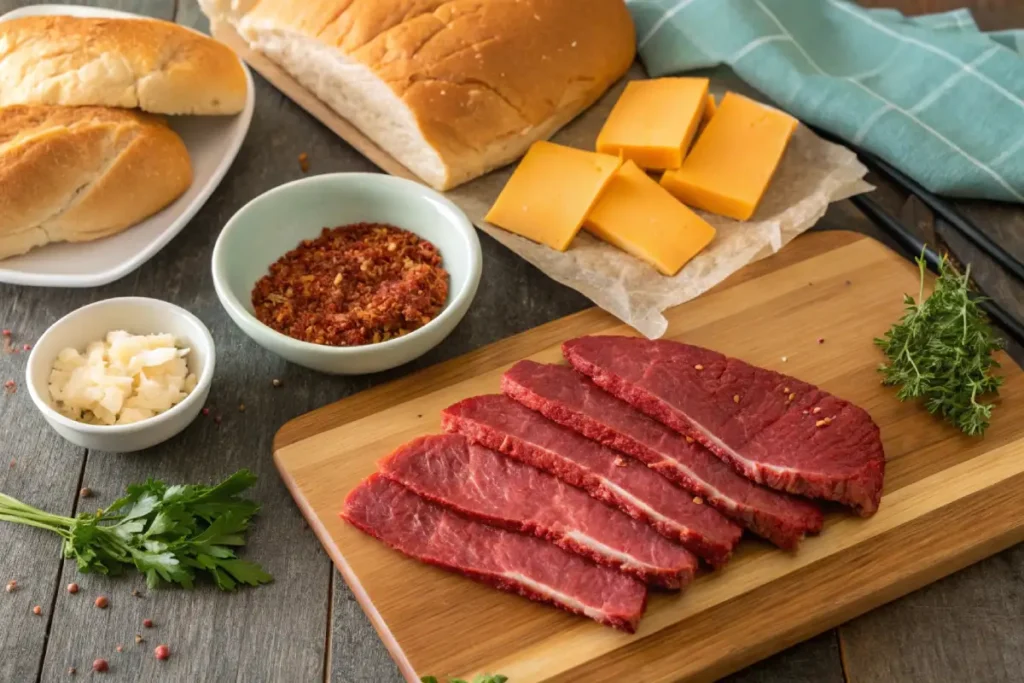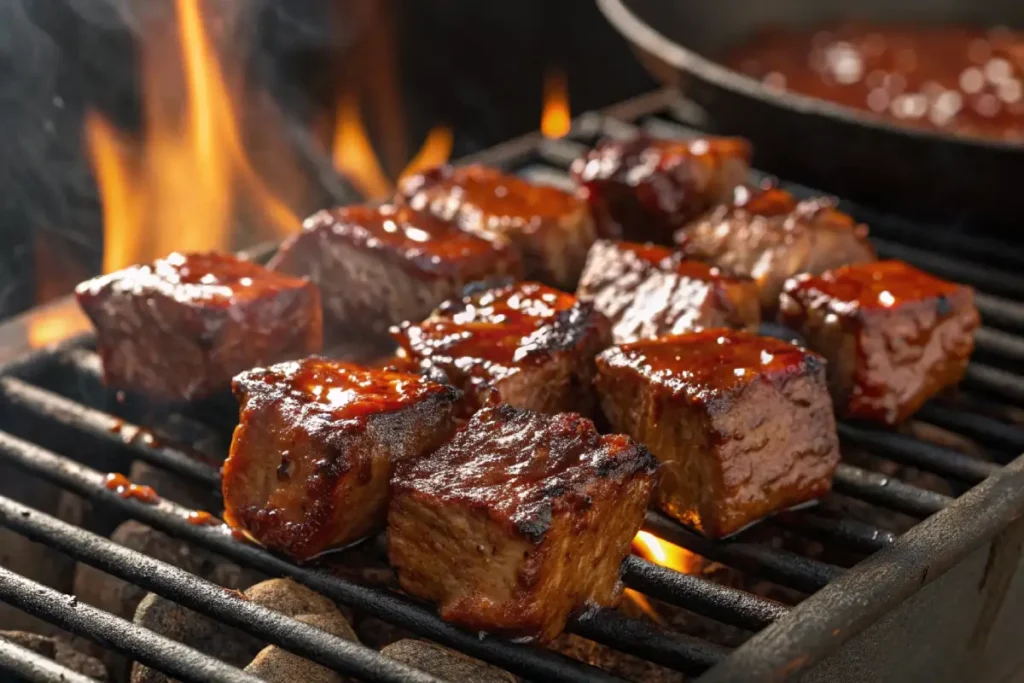Introduction
When it comes to comfort food, the Burnt Ends Cheesesteak is a masterpiece that combines the rich smokiness of BBQ brisket with the cheesy, indulgent magic of a classic Philly cheesesteak. Growing up with BBQ weekends and tailgate parties, I always dreamed of combining two of my favorite dishes into one epic creation. The Burnt Ends Cheesesteak brings together the best of both worlds – the tender, flavorful bites of smoked brisket burnt ends and the melty goodness of a cheesesteak. Whether you’re hosting a backyard BBQ or looking for a next-level sandwich, this recipe will have everyone begging for seconds.
Table of Contents
What Is a Burnt Ends Cheesesteak?
The Origins of Burnt Ends
Burnt ends, often referred to as “meat candy,” originated in Kansas City barbecue culture. These are the crispy, caramelized ends of a smoked brisket, packed with smoky flavor and a slightly charred texture. Traditionally, they were considered scraps, but pitmasters soon realized their incredible taste and gave them star status.
For those new to BBQ, explore more about smoked meat techniques to perfect your approach.
How Cheesesteaks Became a Culinary Icon
The Philly cheesesteak, on the other hand, is a classic sandwich that hails from Philadelphia. Known for its thinly sliced beef, gooey melted cheese, and fresh hoagie rolls, the cheesesteak has become a staple in American comfort food. It’s loved for its simplicity and ability to satisfy even the biggest appetites.
Why Burnt Ends and Cheesesteaks Are a Match Made in Heaven
Combining burnt ends and cheesesteaks is a genius move. The smokiness of the burnt ends adds depth to the cheesesteak, while the cheese and soft bread balance out the bold barbecue flavors. The result? A sandwich that’s both savory and indulgent, offering layers of flavor and texture in every bite. This fusion isn’t just a meal – it’s an experience. Want to learn about other innovative BBQ dishes? Check out these must-try BBQ recipes for inspiration.
Key Ingredients for a Perfect Burnt Ends Cheesesteak
Choosing the Best Meat: Brisket for Burnt Ends
The foundation of any great Burnt Ends Cheesesteak starts with the brisket. The flat cut is ideal for slicing, while the point cut is perfect for burnt ends because of its higher fat content. The fat melts down during the smoking process, creating tender, flavorful bites with crispy, caramelized edges. Look for USDA Prime brisket to ensure excellent marbling, which is key for juicy burnt ends.
Essential Cheeses for Cheesesteak Magic
When it comes to cheesesteaks, the cheese is what ties everything together. While provolone is a classic choice, you can also use:
- Cheez Whiz: For a creamy, authentic Philly vibe.
- Mozzarella: Adds a mild, stretchy texture.
- Sharp Cheddar: Brings a tangy punch to balance the sweetness of burnt ends.
For the ultimate experience, consider mixing cheeses for a blend of flavors and textures.
The Role of Fresh Bread: Picking the Right Roll
A Burnt Ends Cheesesteak demands the perfect bread. Hoagie rolls are the go-to choice. They’re sturdy enough to hold the fillings without falling apart, yet soft enough to soak up the juices and flavors. For an extra touch, toast the rolls lightly with butter to add a crispy texture and buttery richness.
Seasonings and Sauces: Bringing the Flavor Together
Seasoning the brisket is where the magic begins. A good dry rub with a mix of paprika, brown sugar, garlic powder, onion powder, salt, and pepper is essential for those smoky burnt ends.
For sauces, BBQ sauce is a natural fit, but here are some additional ideas:
- Spicy Sriracha Mayo: For a kick of heat.
- Garlic Aioli: Adds creaminess and depth.
- Honey BBQ Glaze: Amplifies the sweetness of the burnt ends.
Pro Tip: Keep some extra sauce on the side for dipping – it’s a game-changer.

Step-by-Step Recipe for Burnt Ends Cheesesteak
Preparing the Burnt Ends: Smoked Brisket Basics
The heart of a Burnt Ends Cheesesteak lies in perfectly smoked brisket. Here’s how to get it right:
- Trim the Brisket: Remove excess fat from the brisket, leaving a thin layer to keep the meat juicy during the smoke.
- Apply a Rub: Generously coat the brisket with a dry rub (paprika, garlic powder, onion powder, salt, pepper, and a touch of cayenne). Let it rest for at least an hour to absorb the flavors.
- Smoke the Brisket:
- Preheat your smoker to 225°F using hickory or oak wood for a rich smoky flavor.
- Place the brisket fat-side up on the smoker rack. Smoke for about 6-8 hours until the internal temperature reaches 165°F.
- Create Burnt Ends:
- Cut the brisket point into 1-inch cubes.
- Toss the cubes in BBQ sauce and brown sugar.
- Return them to the smoker in a foil pan and smoke for another 1-2 hours until they’re caramelized and tender.
Assembling Your Cheesesteak: Tips for Perfection
- Toast the Rolls: Lightly butter the hoagie rolls and toast them in a skillet or oven until golden and slightly crispy.
- Prepare the Filling:
- In a skillet, melt a tablespoon of butter and sauté thinly sliced onions and bell peppers until caramelized.
- Add the burnt ends to the skillet and toss them with the onions and peppers for a flavor-packed mix.
- Melt the Cheese:
- Place slices of cheese (provolone, cheddar, or mozzarella) directly over the burnt ends mixture in the skillet.
- Cover the skillet with a lid to melt the cheese evenly.
Adding the Finishing Touches: Sauces and Garnishes
- Layer It Up: Fill the toasted hoagie rolls with the burnt ends mixture, making sure to pack in the cheese, onions, and peppers.
- Sauce It Up: Drizzle your favorite BBQ sauce or a spicy mayo over the filling for extra flavor.
- Optional Garnishes: Add chopped parsley, pickled jalapeños, or a sprinkle of crushed red pepper for a unique twist.
Pro Tip: Serve the cheesesteaks immediately while the cheese is still gooey and the bread warm.
Pro Tips for Cooking Burnt Ends and Cheesesteaks
Secrets to Smoking Brisket Like a Pitmaster
- Low and Slow Is the Way to Go: Smoking brisket requires patience. Maintain a consistent temperature of 225°F throughout the process to ensure the meat becomes tender and flavorful.
- The Right Wood Matters: Hickory and oak are popular choices for their balanced smoky flavor, but for a sweeter touch, try cherry or applewood.
- Use a Water Pan: Place a pan of water in the smoker to keep the air humid. This prevents the brisket from drying out during the long cooking process.
- Rest the Brisket: After smoking, let the brisket rest for at least 30 minutes before cutting. This redistributes the juices, resulting in tender, melt-in-your-mouth bites.
Getting That Perfect Sear on Burnt Ends
- Caramelization is Key: Toss the brisket cubes in BBQ sauce and brown sugar before returning them to the smoker. The sugar caramelizes, creating that signature sticky, crispy texture.
- Don’t Overcook: Burnt ends should be tender but still hold their shape. Overcooking can make them mushy. Aim for an internal temperature of 195–205°F.
- Use High-Heat Zones: If you’re in a hurry, place the burnt ends briefly on a hot grill to achieve that caramelized crust without drying them out.

Avoiding Common Cheesesteak Mistakes
- Don’t Skimp on Quality Bread: The bread can make or break your cheesesteak. Use fresh hoagie rolls that can soak up the juices without falling apart.
- Thin Slices are Non-Negotiable: If you’re slicing meat for your cheesesteak, ensure the slices are thin to allow for even cooking and easy layering in the sandwich.
- Cheese Distribution Matters: Spread the cheese evenly across the filling. Melting it directly over the meat in the skillet ensures every bite is cheesy perfection.
- Too Much Sauce Can Ruin It: While sauces elevate the flavor, overdoing it can make the bread soggy. A light drizzle or serving sauce on the side works best.
Variations of the Burnt Ends Cheesesteak
Spicy Jalapeño Burnt Ends Cheesesteak
Turn up the heat by adding spicy elements to your Burnt Ends Cheesesteak:
- Spicy Marinade: Add cayenne pepper and chili powder to the brisket rub for extra kick.
- Jalapeño Boost: Sauté fresh jalapeño slices with onions and bell peppers to infuse heat into the filling.
- Pepper Jack Cheese: Replace provolone with pepper jack for a creamy yet spicy finish.
- Sriracha Drizzle: Top it all off with a generous drizzle of sriracha mayo or hot BBQ sauce.
BBQ Fusion Cheesesteak
For a smokier, BBQ-focused flavor, lean heavily on BBQ elements:
- BBQ Sauce Everywhere: Use your favorite BBQ sauce not only for the burnt ends but also as a glaze over the bread before toasting.
- Smoked Cheddar: Incorporate smoked cheddar or gouda for a richer BBQ essence.
- Coleslaw Twist: Add a layer of creamy coleslaw to the sandwich for a tangy crunch that complements the smoky meat.
- Sweet Heat: Include candied jalapeños or a honey BBQ glaze for a sweet-spicy fusion.
Vegetarian Take: Jackfruit “Burnt Ends” Cheesesteak
Yes, even vegetarians can enjoy a version of this masterpiece:
- Jackfruit as the Star: Use jackfruit chunks marinated in BBQ sauce and spices. Roast them in the oven or cook them on the grill until caramelized.
- Cheese Choices: Stick with classic provolone or a plant-based cheese alternative.
- Veggie Power: Add sautéed mushrooms, onions, and bell peppers for a robust, meaty flavor profile.
- Vegan-Friendly Rolls: Use vegan-friendly hoagie rolls to keep the dish completely plant-based.
Experimenting with these variations not only adds fun to the cooking process but ensures there’s a Burnt Ends Cheesesteak for every palate!
Pairing Sides and Drinks with Burnt Ends Cheesesteak
Classic Fries and Dips
A Burnt Ends Cheesesteak wouldn’t be complete without a hearty side of fries. Here are some ways to make them pop:
- Crispy Garlic Parmesan Fries: Toss freshly fried fries in garlic butter and sprinkle with parmesan cheese.
- Sweet Potato Fries: Perfect for a sweet and savory contrast. Serve with a spicy aioli or maple BBQ dip.
- Loaded Cheese Fries: Smother your fries in melted cheese, bacon bits, and green onions for a decadent pairing.
Craft Beer Pairings for BBQ Goodness
The smoky flavors of burnt ends and the cheesy richness of the cheesesteak beg for the perfect beverage. Enter craft beer!
- Hoppy IPAs: The bitterness of an IPA cuts through the richness of the cheese and brisket.
- Amber Ales: Their malty sweetness complements the caramelized burnt ends.
- Smoked Porters: Enhance the smoky BBQ flavor with a porter that has hints of roasted malt and chocolate.
Not into beer? Try a classic cola for its crisp, refreshing counterbalance or a tangy lemonade to cut through the heaviness of the dish.
Sweet and Savory Sides to Complement
Round out your meal with sides that bring variety:
- Cornbread Muffins: Their soft, slightly sweet texture complements the smokiness of the cheesesteak.
- BBQ Baked Beans: The smoky-sweet flavors of baked beans are a natural pairing.
- Creamy Coleslaw: Its tangy crunch adds a refreshing balance to the richness of the sandwich.
- Grilled Veggies: Add a touch of charred goodness with grilled asparagus, zucchini, or corn on the cob.
Pairing your Burnt Ends Cheesesteak with the right sides and drinks takes the meal to the next level, offering a balanced, flavorful experience from start to finish.
Healthier Twists on Burnt Ends Cheesesteak
Low-Carb and Keto-Friendly Versions
If you’re watching your carbs, you don’t have to miss out on the deliciousness of a Burnt Ends Cheesesteak. Here’s how to make it keto-friendly:
- Swap the Bread: Replace hoagie rolls with a low-carb wrap, lettuce cups, or even portobello mushroom caps for a bread-free option.
- Cheese Is Your Friend: Stick with full-fat cheeses like provolone, mozzarella, or cheddar, which are keto-approved.
- Sugar-Free BBQ Sauce: Choose a BBQ sauce made with natural sweeteners like stevia or erythritol to cut down on sugar.
For more ideas on balancing flavor and health, discover this guide to low-carb BBQ dishes that won’t sacrifice taste.
Substituting Low-Fat Cheeses Without Sacrificing Flavor
For a lighter take, opt for reduced-fat cheeses:
- Provolone Light: A low-fat version of provolone offers the same mild creaminess with fewer calories.
- Part-Skim Mozzarella: Maintains the cheesy stretch without the extra fat.
- Greek Yogurt-Based Cheese Sauce: Create a creamy sauce using Greek yogurt mixed with shredded cheese and a touch of mustard for flavor.
Making It Gluten-Free: Best Bread Alternatives
For those avoiding gluten, there are plenty of delicious alternatives to traditional hoagie rolls:
- Gluten-Free Buns: Many stores now carry soft and sturdy gluten-free sandwich rolls that work perfectly.
- Cauliflower Sandwich Thins: A low-carb, gluten-free option that adds a touch of veggies to your meal.
- Rice Paper Wraps: Light and chewy, these wraps offer a unique twist to the sandwich.
Extra Tips for Healthier Prep
- Grill instead of sautéing onions and peppers to use less oil.
- Reduce the amount of cheese used by mixing it with more vegetables for a balanced filling.
- Opt for leaner cuts of brisket or trim excess fat before cooking.
Healthy doesn’t have to mean boring, and these tweaks prove that you can enjoy a guilt-free version of a Burnt Ends Cheesesteak without losing the flavors you love.
The History and Popularity of Burnt Ends Cheesesteak
Where It All Began: A Cultural Food Phenomenon
Burnt ends have long been a staple of Kansas City barbecue, beloved for their rich, smoky flavor and tender texture. Initially considered scraps left over from brisket preparation, burnt ends rose to fame when pitmasters realized their crispy, caramelized edges and juicy centers were culinary gold. Today, they’re considered a barbecue delicacy, often served as appetizers or part of a hearty BBQ platter.
Meanwhile, the cheesesteak has its roots in Philadelphia. The sandwich was first created in the 1930s by Pat Olivieri, a hot dog vendor who decided to grill some beef and onions for a sandwich. The combination was so irresistible that it quickly gained popularity, eventually evolving into the iconic Philly cheesesteak we know today.
Why BBQ and Cheesesteaks Are Thriving in the Food Scene
The fusion of these two beloved dishes – burnt ends and cheesesteaks – is a testament to the creativity of modern comfort food. BBQ has seen a resurgence thanks to the popularity of backyard smoking, food trucks, and competitive barbecue shows. Similarly, cheesesteaks have become a nationwide favorite, offering a hearty, no-fuss meal that’s both indulgent and satisfying.
Combining the two creates a hybrid dish that appeals to fans of bold, smoky flavors and cheesy, savory goodness. Burnt Ends Cheesesteak embodies the best of both worlds, making it a must-try for food lovers seeking something unique yet familiar.
FAQs About Burnt Ends Cheesesteak
What cut of meat is burnt ends?
Burnt ends come from the point cut of a beef brisket. This section of the brisket has a higher fat content, which makes it perfect for rendering down into tender, juicy bites with caramelized, crispy edges after smoking.
What is the secret ingredient in a Philly cheesesteak?
The secret ingredient in a Philly cheesesteak is Cheez Whiz, a creamy processed cheese sauce that adds the iconic, velvety texture and rich flavor. While provolone and American cheese are popular alternatives, many purists swear by Cheez Whiz for the authentic Philly experience.
Why are they called burnt ends?
They’re called “burnt ends” because of their appearance and preparation. These are the crispy, caramelized edges of the brisket point cut that are chopped into cubes and smoked again with sauce, giving them a dark, “burnt” look. Despite the name, they’re not actually burnt – they’re intensely flavorful with a sweet, smoky crust.
What kind of meat is used for a Philly cheesesteak?
Traditional Philly cheesesteaks use thinly sliced ribeye steak. Ribeye is prized for its tenderness, flavor, and marbling, which makes it perfect for quick cooking on a griddle or flat top. It’s seasoned lightly to let the natural flavor of the meat shine through.
Conclusion and Final Tips
Bringing It All Together: Why Burnt Ends Cheesesteak Is a Must-Try
The Burnt Ends Cheesesteak is more than just a sandwich – it’s an unforgettable culinary experience. It combines the smoky richness of BBQ burnt ends with the gooey, cheesy indulgence of a classic Philly cheesesteak. Every bite is a perfect harmony of flavors and textures, making it a crowd-pleaser for backyard barbecues, game days, or simply treating yourself to something extraordinary.
Experimenting with Flavors: Make It Your Own
One of the best things about this dish is its versatility. From spicy variations with jalapeños and pepper jack cheese to BBQ-inspired versions with coleslaw and smoked cheddar, the possibilities are endless. Don’t be afraid to get creative with toppings, sauces, and bread choices to customize the sandwich to your taste.
A Quick Recap for First-Timers
- Start with Quality Ingredients: Use premium brisket, fresh rolls, and your favorite cheese.
- Follow the Process: Smoke the brisket low and slow, caramelize the burnt ends, and melt the cheese evenly for the best results.
- Serve Fresh: This sandwich is best enjoyed hot and fresh to capture the full burst of flavors.
Whether you’re a seasoned BBQ pitmaster or a home cook looking to try something new, the Burnt Ends Cheesesteak is a recipe that delivers every time. So fire up the smoker, grab your favorite cheese, and get ready to enjoy the best of both BBQ and cheesesteaks in one mouthwatering creation.
